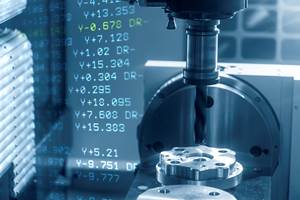Controlling Your CNC Display Screens
CNC manufacturers have begun offering programs that allow end users to customize how display screen pages look and work.
Share





We traditionally think of the display screen pages provided by CNC manufacturers as fixed and unchangeable. We work within the confines of what is provided and do what is needed to get our tasks done.
Need to see the distance-to-go value? Call up the program check display screen page. Need to enter a tool offset? Select the offset display screen page. Want to modify a program? That’s done on the program display screen page.
But have you ever found yourself questioning the way display screens are arranged or wanted to modify the way they work? Until recently, you were out of luck in this regard. Now, however, some CNC manufacturers have begun to provide a way to modify this human-machine interface (HMI), allowing you to create custom display screen pages that are more in line with your company’s specific needs. The program used to create custom display screens for FANUC CNCs is called FANUC Picture, and I will use it here as a reference to describe some of what is possible. Other CNC manufacturers likely have similar programs.
The original intent of the CNC manufacturers was to give machine tool builders and integrators the ability to customize the machines they sell—not to help end users. This is similar to the thinking behind FANUC’s Custom Macro parametric programming language. Custom Macro originally was created to allow machine tool builders to interface with certain accessory devices, like probing and post-process gaging systems. FANUC never dreamed this ability would be so important to end users. As we now know, Custom Macro has provided countless benefits to end users who have mastered its capabilities.
The potential benefits of creating custom display screens are even more formidable. FANUC Picture provides full access to CNC functions (offsets, parameters and so on) and programable machine controller (PMC) functions. Scripts can be written to instruct the CNC and PMC, making them perform just about any imaginable task, from turning on a light to changing a tool offset
As an example, consider the sizing adjustment application discussed in a CNC Tech Talk column earlier this year. I suggested using a spreadsheet running on a mobile device to specify measured dimensions. The spreadsheet responds with the offsets to be changed along with the deviation amounts. While this simplifies the process of making sizing adjustments, it still requires the operator to make the related offset entries. With FANUC Picture, a custom display screen can be created to close the loop, performing the tasks of the spreadsheet and modifying the appropriate offsets.
This application barely scratches the surface of what is possible. As with Custom Macro, you really need to start wrestling with FANUC Picture before its implications and potential applications become more obvious.
Unlike with Custom Macro, however, you’ll need more than just a Custom-Macro-equipped CNC to begin. You will need FANUC Picture to create screens and FANUC NCGuide CNC software running on a PC to test your screens before you can go live on an actual machine. And creating custom screens is easiest with CNCs that have touchscreen displays.
You also should be prepared to face a learning curve. Again, unlike with Custom Macro, it will be more difficult to master a customization program like FANUC Picture than simply studying a manual. FANUC does offer face-to-face and online classes that will help you get started. If you have the right applications in place, this will result in time and money well spent.
Related Content
Tips for Designing CNC Programs That Help Operators
The way a G-code program is formatted directly affects the productivity of the CNC people who use them. Design CNC programs that make CNC setup people and operators’ jobs easier.
Read More2 Secondary Coordinate Systems You Should Know
Coordinate systems tell a CNC machine where to position the cutting tool during the program’s execution for any purpose that requires the cutting tool to move.
Read More6 Machine Shop Essentials to Stay Competitive
If you want to streamline production and be competitive in the industry, you will need far more than a standard three-axis CNC mill or two-axis CNC lathe and a few measuring tools.
Read More4 Rules for Running a Successful Machine Shop
Take time to optimize your shop’s structure to effectively meet demand while causing the least amount of stress in the shop.
Read MoreRead Next
Last Chance! 2025 Top Shops Benchmarking Survey Still Open Through April 30
Don’t miss out! 91ÊÓƵÍøÕ¾ÎÛ's Top Shops Benchmarking Survey is still open — but not for long. This is your last chance to a receive free, customized benchmarking report that includes actionable feedback across several shopfloor and business metrics.
Read MoreAMRs Are Moving Into Manufacturing: 4 Considerations for Implementation
AMRs can provide a flexible, easy-to-use automation platform so long as manufacturers choose a suitable task and prepare their facilities.
Read MoreMachine Shop MBA
Making Chips and 91ÊÓƵÍøÕ¾ÎÛ are teaming up for a new podcast series called Machine Shop MBA—designed to help manufacturers measure their success against the industry’s best. Through the lens of the Top Shops benchmarking program, the series explores the KPIs that set high-performing shops apart, from machine utilization and first-pass yield to employee engagement and revenue per employee.
Read More.jpg;width=70;height=70;mode=crop)






















